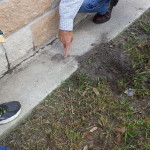General Information

Exterior inspections can help coordinators and pest management professionals find potential pest problems before them come inside.
Because fire ants may present a hazard to children who are allergic to their venom, fire ant control should be made a top priority around athletic fields, playgrounds and classroom buildings. Emphasize year-round suppression of fire ant activity in landscapes in and around buildings because fire ant mounds are usually located outdoors. Fire ant baits provide excellent control and are considered a preferred treatment. Where fire ant mounds are not numerous, individual mounds may be treated with baits or contact insecticides according to label directions.
Imported fire ants deliver painful stings resulting in a white, bump-like pustule. They make prominent mounds from which they emerge quickly and aggressively when disturbed.
Identification
 Fire ants are reddish brown to black depending on where you reside. The workers range in size, 1/16 inch to 1/4 inch, and are black, reddish brown or red and black. The waist (pedicel) has two nodes. The antennae are 10-segmented with a two-segmented club. These ants respond quickly to nest disturbance and readily sting people and pets. Painful stings result in a pustule that lasts several days.
Fire ants are reddish brown to black depending on where you reside. The workers range in size, 1/16 inch to 1/4 inch, and are black, reddish brown or red and black. The waist (pedicel) has two nodes. The antennae are 10-segmented with a two-segmented club. These ants respond quickly to nest disturbance and readily sting people and pets. Painful stings result in a pustule that lasts several days.
Suggested Thresholds
- Outdoors: Four to five mounds should trigger a broadcast bait application. One mound is sufficient to justify an individual mound treatment.
- Indoors: Respond to any fire ant complaint. Treat when more than one ant is observed per classroom. Confirm ant is truly a fire ant species
Monitoring and Inspection
- Regular visual inspection of school grounds (and adjacent areas) can help to identify ant activity and determine the need for remedial action.
- In regularly infested areas, routine, calendar-based broadcast bait application is often recommended as a more efficient way to reduce ant populations and stings compared to inspecting and treating mounds as they occur.
- Broadcasting baits may also reduce the overall amount of insecticide applied.
- In and around buildings check all windows and doors for tight seals. Check roof and outside areas for mounds and possible entry points.
Nonchemical Control Measures
Maintaining thick, healthy turf can reduce the number of southern fire ant mounds present on school and neighboring property. Southern fire ants prefer bare soil with direct sun exposure; however, other fire ant species are not as easily deterred.
Sanitation/Cultural Control Measures
Regular mowing may knock down mounds and cause mound movement, but probably will not reduce the number of mounds.
Physical/Mechanical Control Measures
Seal all suspected ant entry points into buildings. Fix or repair door sweeps.
Chemical Control Measures
Broadcast applications of an Insect Growth Regulator (IGR) bait containing methoprene or pyriproxifen; or non-IGR products containing abamectin, indoxacarb, hydramethylnon or spinosad, can be applied in the spring and fall for continued control. IGR baits may be applied to turfgrass areas during spring or summer vacations. For fast control of problem mounds, apply a non-IGR bait or contact insecticide to mounds. Baits are most effective when fire ants are actively foraging, i.e., when temperatures are between 70 and 90 degrees F.
Liquid, granular, dust or aerosol contact insecticide treatments may be used to eliminate individual mounds.
Surface-applied, slow-acting, long-residual, contact insecticides such as pyrethroids or fipronil where maximum suppression is desired can also be used. Remember to use caution when making these applications and to keep students and staff out of the area until these products have been watered into the soil and the application area has dried.
Faster acting toxicant baits such as hydramethylnon, indoxacarb or spinosad should be applied around colonies or mounds that extend under sidewalks or other pavement areas.
Barrier treatments using contact insecticides around perimeter walls may reduce the number of ants foraging indoors if an immediate problem exists.
Pyrethrum sprays may be applied to ant entry points only in emergency situations where fast control is needed and caulking or sealing is not possible.
Always read and follow the label. The label is the law. Pesticides must be used in accordance with federal, state and local regulations. Applicators must have proper credentialing to apply pesticides and should always wear personal protective equipment (PPE) as required by the pesticide label during applications. All labels and Safety Data Sheets (SDS) for the pesticide products authorized for use in the IPM program should be maintained on file.
Evaluation Methods
IGR baits generally take up to eight weeks before control can be seen. Faster acting toxicant baits generally will net results in several days to several weeks. The most effective fire ant management program is based on a proactive approach to prevent infestation rather than a reactive one once you have a problem.
